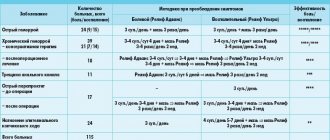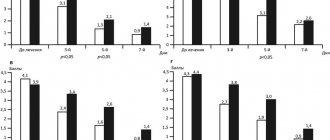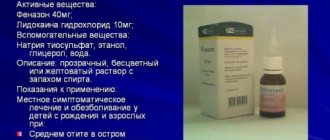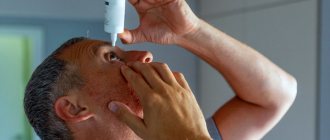Balarpan n eye cornea protector gel 5ml
pharmachologic effect
Tissue repair stimulator.
Composition and release form Balarpan n eye cornea protector gel 5ml
Solution - 1 ml:
- Active substance: 0.0001 g of sulfated glycosaminoglycans;
- Excipients: Sodium chloride, purified water.
Eye drops 0.01%.
Eye drops 0.01% in neutral glass bottles of 5 and 10 ml, or polypropylene plastic bottles of 5 and 10 ml, or a polyethylene dropper tube of 1.5 ml. 1 bottle or 1 dropper tube with instructions for use in a cardboard box. The dropper cap is placed in a cardboard box with a glass or plastic bottle.
Description of the dosage form
Transparent colorless solution, slight opalescence is allowed.
Directions for use and doses
- For any damage to the cornea, including surgical ones, 1-2 drops 4-5 times a day for 7 days;
- for keratitis, keratoconjunctivitis, dry eye syndrome, 1-2 drops 4-5 times a day for 1 month;
- for contact correction, the first 3 days when adapting to wearing contact lenses 2 times a day in the morning and evening (after removing the lenses), 2 drops in each eye;
- when wearing contact lenses for a long time, 1-2 drops in the morning and evening in each eye during the entire period of wearing;
- for involutional changes in the cornea, 1-2 drops in the morning and evening for a month.
Pharmacodynamics
Active ingredients - glycosaminoglycans are natural components of the connective tissue of the cornea. Stimulates regenerative processes of the cornea.
Pharmacokinetics
No data.
Indications for use Balarpan n cornea protector gel 5ml
As part of complex therapy:
- erosions, non-penetrating wounds of the cornea, conjunctiva and sclera;
- penetrating wounds of the cornea and sclera after surgical treatment;
- burns of the cornea, conjunctiva, sclera (chemical and thermal);
- damage to the cornea as a result of surgical interventions (keratotomy, keratomileusis, keratoplasty, cataract extraction);
- dry eye syndrome;
- keratitis, including with corneal ulceration;
- keratoconjunctivitis;
- epithelial-endothelial dystrophy of the cornea;
- for contact vision correction to improve the tolerability of contact lenses;
- as a prophylactic for involutional changes in the cornea.
Contraindications
Hypersensitivity to the components of the drug, children under 18 years of age, pregnancy, breastfeeding (due to the lack of data on effectiveness and safety).
Overdose
There is no data on drug overdose.
Side effects Balarpan n eye cornea protector gel 5ml
Conjunctival hyperemia, allergic reactions.
BALARPAN (drops)
Tom left.
I had to close my other eye as well. From 3 pm to 9 pm I sat with my eyes closed; from 9 pm it became possible to open the right one, although the unpleasant sensations when it rotated in the left eye still caused great inconvenience. TREATMENT
While I could still keep one eye open, one eye open. I read stories of similar injuries on the forum and learned the recommendations of ophthalmologists.
The most important thing is to prevent the occurrence of an inflammatory process by instilling an antibiotic into the eye. Also prescribed (ointments, gels, drops) are drugs that accelerate the healing of the corneal epithelium. I was unable to go to the doctor on the day of the injury: there was no one to leave the child with, so I did as was written on the forum.
PROPERTIES OF THE DRUG
I started using Balarpan as a drug for healing corneal epithelial defects. This drug is widely used in ophthalmology and ophthalmic surgery, since it contains hypromellose, a protector of the corneal epithelium, and glycosaminoglycans, heteropolysaccharides of natural origin that are part of the cornea of the eye.
Hypromellose lubricates the epithelium of the cornea while reducing the secretion of tear fluid and provides a softening effect.
Glycosaminoglycans have anti-inflammatory activity and have an anti-edematous effect on damaged tissues. Due to the viscous consistency of Balarpan N, the contact of its components with the cornea of the eye is prolonged.
RELEASE FORM Balarpan N is a clear, colorless, odorless liquid with a viscous consistency, which is a solution of salt, water, glycosaminogycans and hypromellose.
Available in different forms. A 10 ml solution is sold in a glass bottle with a dropper cap. At the moment, the lid is lost, the sterility of the drug is compromised.
DOCTOR'S APPOINTMENT
After 2 days, I went to the eye microsurgery department of the clinic to consult a doctor. The doctor looked at my eye using the machine. The scratch was visible, but was healing well. I told you what I did for treatment for two days after the injury. The doctor approved my treatment and did not prescribe anything other than Balarpan N and Tsipromed.
EFFICIENCY
The next day after the injury, no pain was noted in the eyeball. Blinking and rotating the eyeball did not cause any unpleasant sensations. But after the injury, disturbances in the visual function of the eye were observed: cloudy blurry images, double vision. Up close, the double vision seemed minimal, but in the distance, each object that I tried to see had several contours that were 1-3 cm behind each other. I became afraid that this would not go away.
During the examination, the doctor explained that the cloudiness and blurriness of the image were due to the fact that the scratch on the cornea had not yet “resolved.” Double vision is a consequence of a violation of accommodation after an injury.
On the third day after the injury, the function of the organ of vision returned to normal: the horizontal doubling of objects stopped, the image became the same as it was before the injury.
RESULT Balarpan N helped to quickly regenerate the damaged epithelial layer of the cornea.
Eye drops after vision correction: which are better?
— I’ve come across reviews from people who would like to unscrew everything back, albeit for poor eyesight, but without problems with dry eyes. - Well, nooooo! ))
Overheard on one of the forums
Laser vision correction is a highly effective and affordable method for correcting most refractive pathologies. But this is a surgical intervention, which has its own rehabilitation period. New vision stabilizes on average (for different types of operations) after a month. By this time, the tissue healing process is completed. In order for the rehabilitation to go smoothly, it is imperative to instill special drops into the operated eye. What, why and for how long to drip, we explain in this article.
Why are drops needed after eye surgery?
After laser vision correction, all patients, without exception, are prescribed two types of eye drops:
- antibacterial,
- moisturizing.
Antibacterial drops
After laser operation, a wound surface remains on the cornea. In PRK, it is covered with a protective lens; in LASIK, it is covered with a corneal flap bent during the operation. Until it heals, it must be protected from infections. Antibacterial drops are prescribed starting from the day of surgery for a week. They need to be dripped according to a certain pattern, several times during the day, in order to maintain the concentration of the medicine at the required level.
The drops need to be applied several times a day. This way the desired concentration of the drug is maintained.
A week later, at a follow-up examination in the clinic, depending on the dynamics of healing, the doctor decides to stop or extend the time of taking the drug. The medication may need to be changed, or additional corticosteroids may be prescribed.
Moisturizing drops
After vision correction, moisturizing drops are prescribed for a month or longer. They imitate human tears, are non-addictive, absolutely harmless and can be used as long and often as necessary.
Why do you have to moisturize your eyes?
One of the most common side effects after laser vision correction is dry eye syndrome. It is temporary and usually goes away within a week to a month. This is a consequence of a laser burn to the cornea and microdamage to the conjunctiva during the installation of an eyelid fixator, as well as the use of various drugs before and during surgery.
After surgery, patients report dryness and burning in the eye, a feeling of a foreign body, as if sand had entered. As a rule, the sensations appear in the late afternoon, and along with them, instability of vision and blurred images. A slight redness of the eye is normal. In bright light, the syndrome intensifies, as does with intense visual stress. Therefore, during the rehabilitation period, it is advisable to wear dark glasses even at home and not overload your eyes.
Moisturizing drops will help improve visual function and relieve discomfort. They promote healing and cleansing of tissues (for example, they mechanically remove dust particles that accidentally enter the eye) and reduce the risk of infection. There is no need to endure discomfort! This is definitely not a reason to test your endurance and not an article for saving money. Fabrics need hydration. Chronic drying of the cornea is dangerous due to the development of complications, which are more difficult and expensive to treat: keratitis, blepharitis, erosions and corneal ulcers. Do not neglect your doctor's advice regarding taking eye drops after vision correction!
Why can't human tears cope?
There is little tear fluid
As a result of damage to eye tissue during surgery, tear production may be temporarily reduced. The cornea dries out. Even in the morning the patient experiences difficulty opening his eyes. Friction when blinking irritates the unhealed edges of the wound and prevents its recovery.
The composition of tears is disrupted
Human tears have a complex composition. A disruption in the production of one of the components affects its quality. For example, due to injury to the conjunctiva, the production of mucins, a gel-like substance that provides adhesion to the tear film and the surface of the eye, suffers. And a reduction in lipid production increases tear evaporation. The film bursts prematurely, not having time to moisturize and nourish the cornea. Dry eye syndrome may be accompanied by profuse lacrimation, which does not bring relief.
Pharmacological support is required - moisturizing drops, but in each situation it is different, aimed at eliminating a specific problem.
What types of moisturizing drops are there?
All moisturizing drops imitate human tears, but they are distinguished by:
- Consistency: liquid and gel-like. A more viscous consistency ensures a long-lasting effect, but is not always convenient for use if you are outside the home, for example, in the office or on the road. Typically, gel-like preparations are prescribed before bedtime.
- Release form. Almost all drops come in small bottles with a dropper spout, but most must be stored in the refrigerator because they are not airtight. There are disposable dropper tubes - they are convenient to take with you and they are hygienic.
- Active substance - to solve various eye problems associated with a feeling of dryness. Preparations based on hyaluronic acid or povidone promote tissue regeneration and compensate for the deficiency of the water-mucin layer of the tear film. As a rule, these eye drops are prescribed immediately after laser vision correction. But if there is a lack of lipids in the tear, they, unfortunately, will not help. A lipid nanoemulsion will be required as a tear substitute, which will prosthetize the lipid layer of tears. But moisturizing drops with a vasoconstrictor component, although they give a good visual effect, as they relieve redness, are not recommended after eye surgery - they prevent the production of your own tears.
Which ones are better? There are no good or bad drops, there are suitable and unsuitable for solving individual problems associated with dry eyes, taking into account the patient's lifestyle.
Choosing your own moisturizing drops is a thankless task. Without knowing what lies behind the discomfort in the eyes in your particular case, you can spend a long time sorting through seemingly identical bottles of drops. And even more so, price should not be a guideline for choice. At best, the drops will not help, at worst, you may miss the onset of a serious illness. It is impossible to independently determine what is happening to the eyes: an allergic reaction or, say, filamentous keratitis, which at the initial stage is similar to the manifestations of dry eye syndrome, but requires different treatment.
Therefore, be sure to consult an ophthalmologist if:
- the drops recommended for you after laser vision correction do not bring relief;
- painful sensations and cloudy discharge from the eye appeared;
- More than a month has passed, and the degree of dry eye has not returned to the preoperative state.
Only on the basis of objective data from additional diagnostics will the doctor determine why the sensations that bother you appeared after laser vision correction and what drops should be applied in this case.
Why do you sometimes have to use moisturizing drops after vision correction for longer than usual?
The quantitative and qualitative parameters of tears are usually restored within the first month after surgery. But it is very rare that the feeling of dryness persists even several years after correction.
There may be several reasons for this:
- dry eye at the time of surgery - if before laser vision correction you regularly had to use moisturizing drops, the syndrome will almost certainly not disappear after the operation;
- high degree of myopia - the deeper the cornea needs to be treated, the more damaged are the nerve endings in it, which are also involved in the production of tears (the healing process of the cornea in these cases can take up to 8-12 months after surgery);
- long-term wearing of soft contact lenses, which have a direct damaging effect on the lacrimal glands and the ocular surface;
- hormonal changes (thyroid disease, menopause in women, and even taking hormonal medications) can lead to dysfunction of the lacrimal glands;
- lack of vitamin A;
- prolonged work at the computer, when the natural blink rate is reduced;
- long stay in an air-conditioned room;
- incorrectly selected moisturizing drops.
If moisturizing drops are not selected correctly, the feeling of dryness in the eyes will persist.
Summarize:
- To help your eyes recover faster after laser vision correction, follow your doctor’s recommendations and take antibiotics and tear substitutes prescribed according to the recommended regimens.
- If your eye condition worsens, contact a specialist immediately; do not select drops for yourself!
- Sometimes long-term use of moisturizing drops is required, but this usually does not cause much inconvenience and does not cause dissatisfaction with the result of the operation. The benefits of having good eyesight outweigh!





